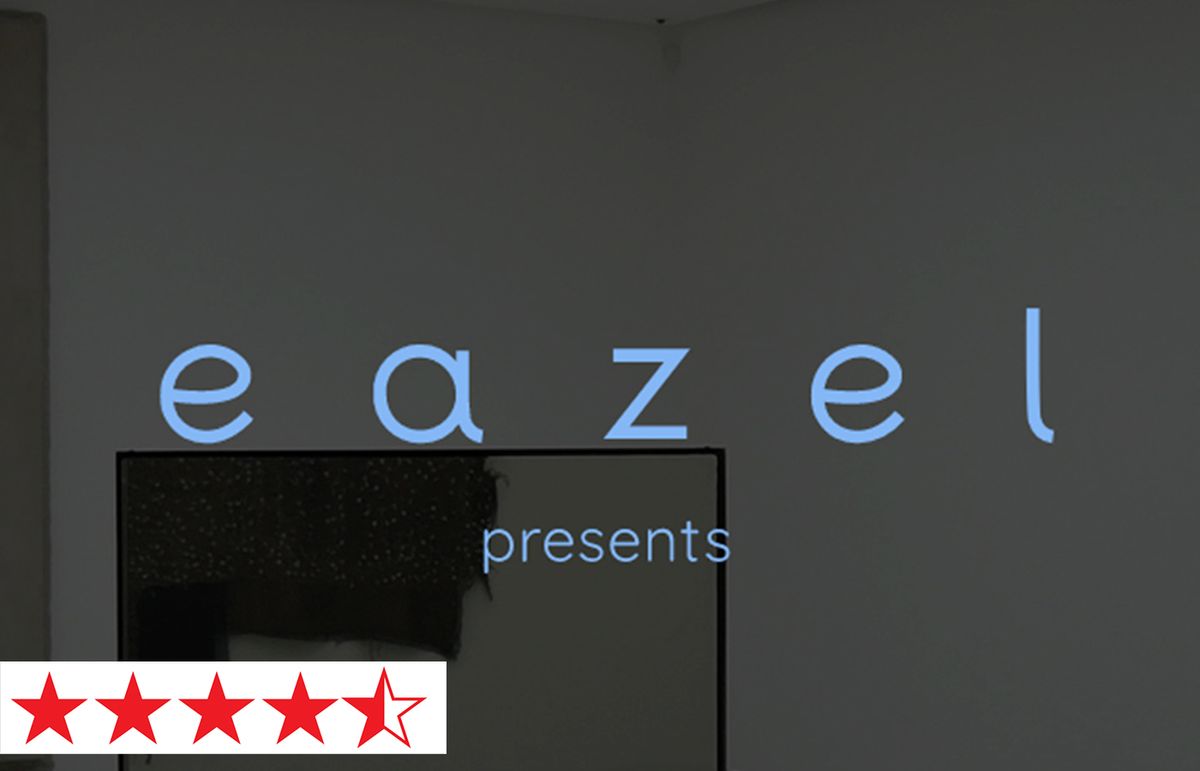What is it?
Eazel is a multi-functional digital art platform that hosts virtual galleries and fairs.
White Cube Hong Kong’s Encounter is a project conceived in two parts that brings together, on the Eazel platform, works by the gallery’s represented artists.
Where to Find it
White Cube Hong Kong's Encounter, on Eazel
XR Curator’s Note
Gretchen Andrew: You may be wondering why we chose to review an exhibition that “ended” three months ago, on 22 August 2020. One of the aspects of VR this panel has been interested in exploring is its archival potential. By selecting an exhibition that is no longer digitally open we wish both to commend Eazel for their maintenance of “past” exhibitions and to open questions about the nature of time within digital and digitally presented art. I have raised before the issue that deprecated, or obsolete, technology can often be more of a problem than threats to the physical objects it reproduces. It’s very cool that we can see this exhibition after its “closure” but the art world should be wary of getting excited about long-term potential, especially in the overlapping software/hardware, both fast-moving, area of virtual reality. What are these platforms doing to maintain museum-quality preservation of these experiences? While we need many platforms, how do the proliferating proprietary platforms impact the preservation of these experiences? One might think that it would be easy for a virtual show to “travel” to a different museum or gallery but, at present, this is far from being the case.
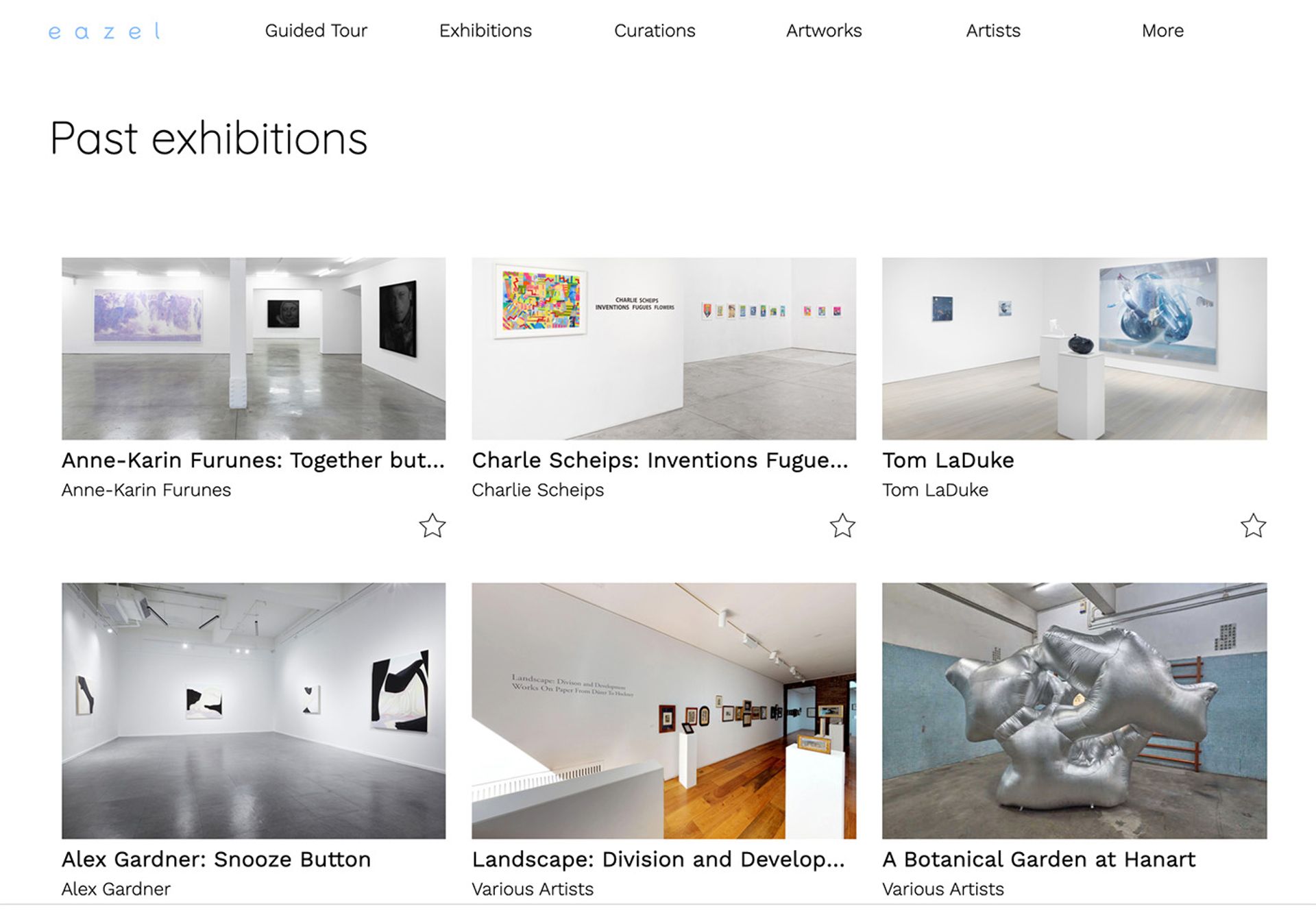
Eazel is strong on maintaining access to past virtual exhibitions
They Say
Never miss a show with our virtual tours. Let us take you there!
"Eazel brings the art world to you. Never miss a show with our virtual tours. Let us take you there!"
"To encounter is to experience and engage, often unexpectedly. This project aims to facilitate such encounters, addressing the similarities, connections and even contradictions that arise. By highlighting the varied artistic attitudes and methods of enquiry, the selection is intended to generate new dialogues between a range of artworks as they 'encounter' one another: in turn proposing new perspectives and understandings."
The XR panel's ratings
Giving an overall panel rating of 4.5/5 stars.
We Say:
A complete, self-contained, digital art ecosystem in the way billion-dollar tech company campuses are
Eron Rauch: Take off your outdoor pants, and grab a comfy chair while I take a deep breath and give you an info dump about what Eazel does. When I say it is a complete, self-contained, digital art ecosystem, I mean that in the way billion-dollar tech company campuses are. Eazel’s platform includes photo-based virtual galleries of specific shows, both past and present, audio tours, full VR headset function—though I could not find a show with this as an option—viewing-room-plus experiences for the galleries, maps to galleries, meta-curated group shows of featured shows, art/artist databases, multiple magazine-style editorial content sections connecting the galleries and artists on the platform, and hosted art events, such as Korea Art Week. Check check check… Are you still there? You can refill your drink now. Wait, nope. There is also a user landing page where you can collect favourite works and shows, follow galleries to make your own little art walk, and track your purchase inquiries with galleries.
I hit the site the way most users likely will, which is in reverse. A friend had recommended checking out Encounter: Part 2 at White Cube Hong Kong, which I Googled and noticed was on Eazel. I made an account, hopped into the virtual show (favourited it to return); read the info about the gallery itself (followed them); saw there was a magazine-style feature on the history of Hong Kong galleries; started searching through the other shows on the site; then read up on Eazel itself.
Reverse this and, yes, that means the story of Eazel takes up the entire above-fold portion of the home page, with art only starting below the scroll. This self-sales-pitch tone is curiously omnipresent throughout the site. The site is squarely aimed at art buyers (you have to specify your relationship to art when you join) but this tone might also be because Eazel is clearly looking to secure partner galleries, with a full sub-website touting the creation process of the platform down to explaining the logo.
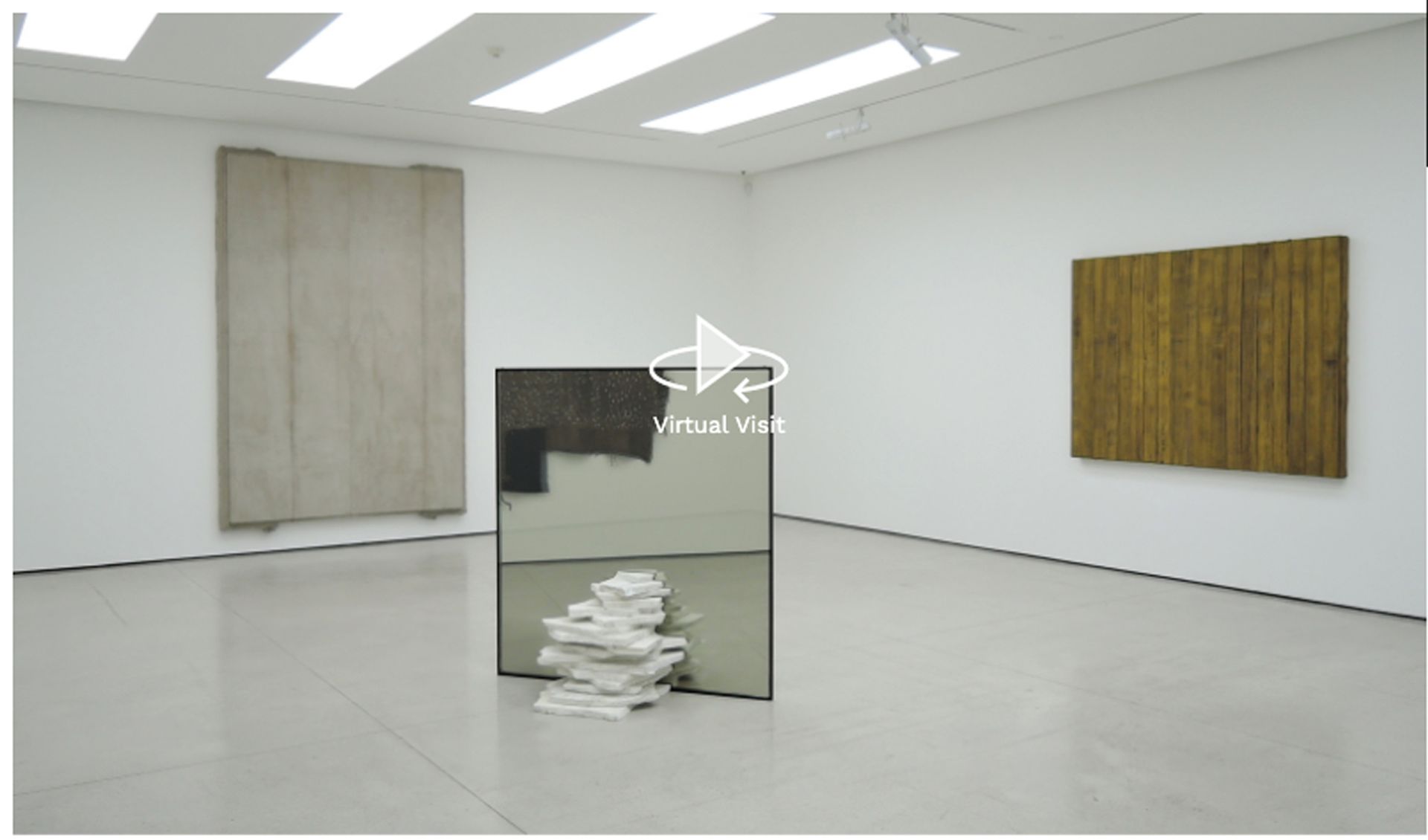
High-res and clear: White Cube Hong Kong's Encounter: Part 2 on Eazel
In the era when the Big Four’s digital dominance has done damage to politics and society, during a pandemic that threatens to eradicate smaller galleries, despite my excitement for Eazel, I can’t help but worry about the control these complete platform holders can exert on what is knowable. Peering out the window of White Cube, there was an expansive view of Hong Kong, red taxis rushing past, a curved building towering beyond trees. I couldn’t help but fire up Google Street View and take a walk around the block. Standing out front, I looked across the endless blocks, floors of buildings flooding my screen. But the only ones I could enter were partnered with Eazel. What new artists, generative shows, and new galleries was I missing along those shadowed storefronts frozen with just the digital ether for a partner?
Frankly, despite some navigation bloat from the endless features and paths, awkwardly advertorial tone, and lack of editorial transparency, Eazel is very good. Only one example is needed to show the care they took: in the 3D galleries, you can turn off the large circular floor and wall text markers that often overwhelm the art in these sorts of platforms! The art is high-res and clear when you zoom in and has accessible info. (I still wish, thought, that these photo-style 3D galleries had a "duck" button to alter a viewer's point of view. The Balka and Hatoum pieces in Encounter: Part 2 really suffer from the lack of vantage points.) Overall, the site is easy to use, fun to find art, and works as smoothly "app-y" on both my crappy old phone and my massive desktop display. Eazel is a top-tier way to explore art in the era of social distancing, whatever type of pants—if any—you’re wearing.
Is the app easy to use
Carole Chainon: White Cube’s Encounter: Part 2 is easy to navigate on Eazel’s web platform. The virtual visits are not compatible with Mozilla so I was redirected to Chrome.
Dhiren Dasu: Quite intuitive and easy to use. I use the Brave browser on my desktop and on my phone. App worked seamlessly on both.
Seol Park: Well conceived and intuitive to use. Works well in iOS and Android.
How good is the art?
Love the Virginia Overton Untitled. Art that bursts out of the frame is always fascinating to me. Especially with the inclusion of the mirror, it affects as well as disrupts the space it is inDhiren Dasu
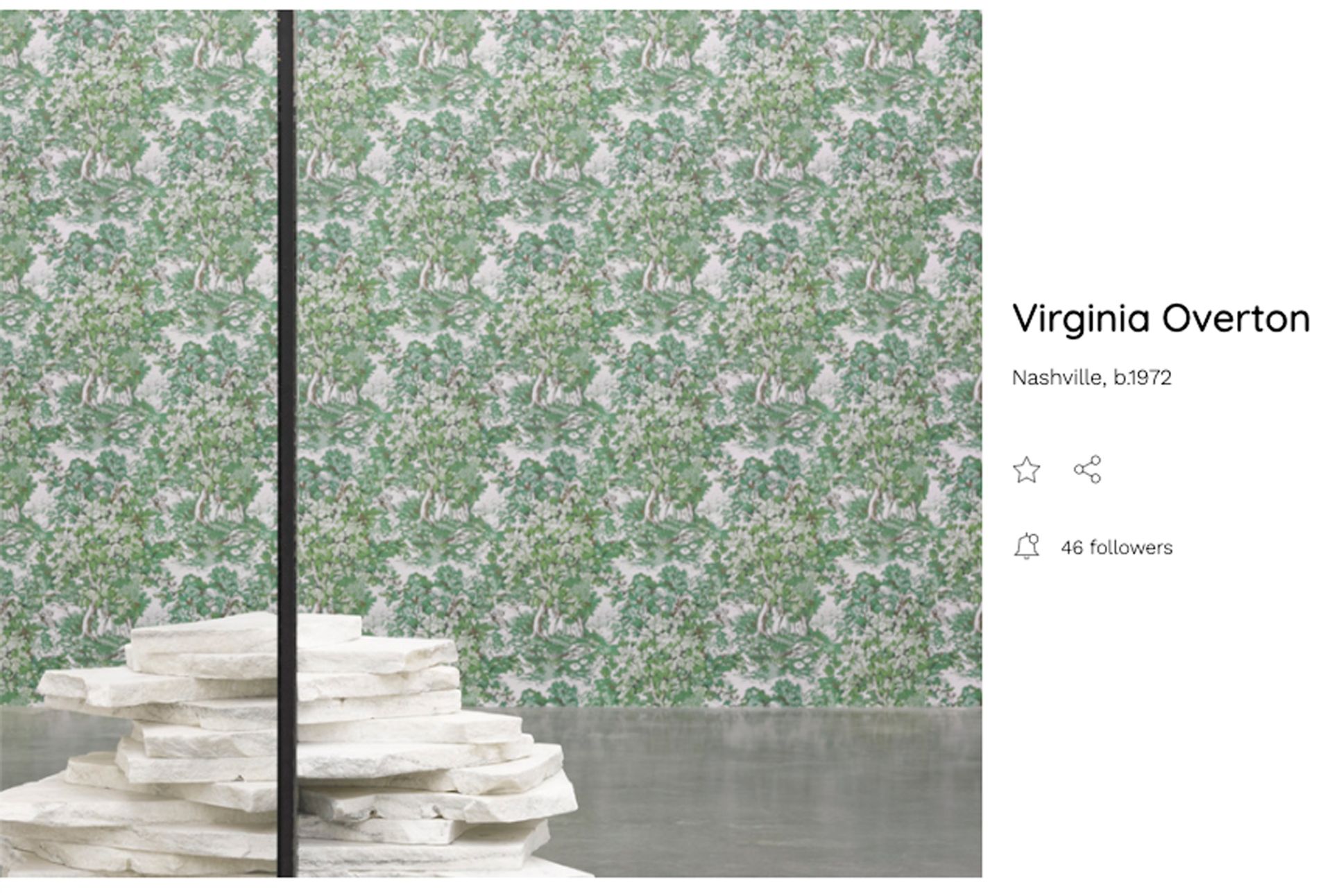
A mesmerising optical illusion: Virginia Overton’s Untitled
Carole Chainon: The artworks are powerful. I enjoyed the contrast of the collection, from the earthy colours and materials in the first room to the bright and bold colours and materials of the third room. The pieces do work together as encounters, as is suggested in the show's title. I appreciated the fact that we could get up close to the artworks displayed with sufficient resolution, even the smallest ones, unlike with other Matterport-style virtual visits.
Dhiren Dasu: There are some excellent works in the exhibition. Love the Virginia Overton Untitled. Art that bursts out of the frame is always fascinating to me. Especially with the inclusion of the mirror, it affects as well as disrupts the space it is in. Warsaw, by Mirosław Bałka, also stood out as an elegant, minimal, piece that communicated everything implied in the title. A link to his CV led me to a deeper understanding of the "fractured history" of Poland's collective memories that his work seeks to express. I also liked the "analog pixel" aesthetic Suzanne II, by Chuck Close.
Seol Park: Two dimensional pieces with strong graphic quality stand out especially well in this presentation. Being able to experience the contrast in scale between Liu Wui's large canvas and the intimate oils by Tracey Emin was a treat. However, the platform is less successful in supporting the uniqueness and strengths of the sculptural encounters in this exhibition: the mesmerising optical illusion of Virgina Overton's Untitled (2016) and the mysterious Tanizakian flickering of Cerith Wyn Evans' chandelier do not come across. Nevertheless, I very much enjoyed the dynamic overall selection.
What is gained by viewing in VR/AR rather than In Real Life?
The virtual presentation is a well-conceived bridge that combines key aspects of a gallery visit with the experience of browsing ArtsySeol Park
Carole Chainon: Eazel brings accessibility and democratisation of the gallery experience to the wider world. It is a treat to be able to to visit White Cube’s Hong Kong exhibit during a pandemic, while sheltered at home, and to be exposed to artworks that spark conversations and new ideas. Some of the exhibits on Eazel’s platform provide audio tours, which is not necessarily the case in real life, so this is an appreciable plus.
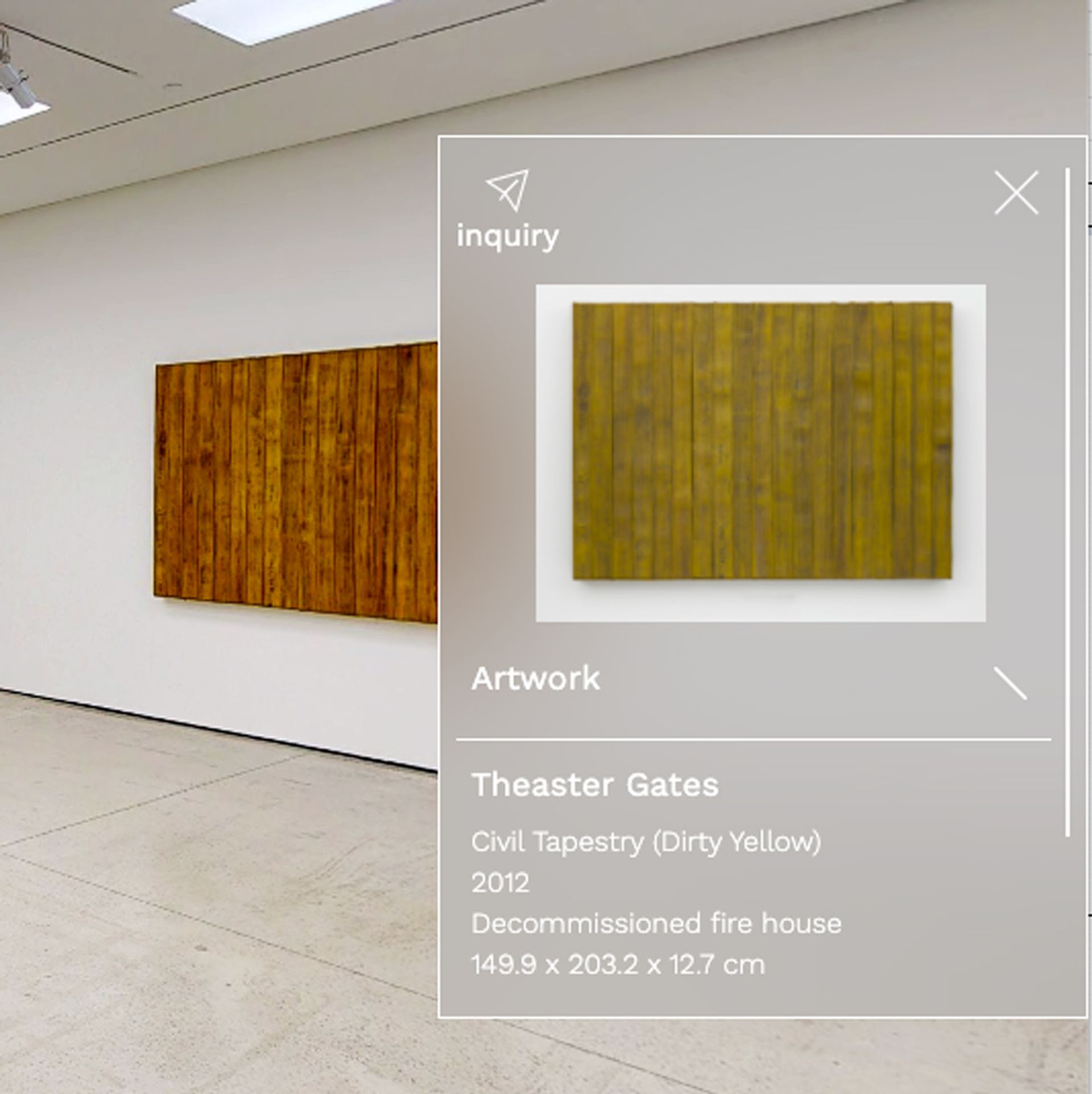
The addition of links to information about the work, artists' CV, as well as an email form to find out more about the work including pricing is unique to this XR implementation
Dhiren Dasu: The addition of links to information about the work, artists' CV, as well as an email form to find out more about the work including pricing is unique to this XR implementation. Essentially, all of the relevant information can be communicated between artist, gallery, collector, press, and casual peruser of art in one simple interface.
Seol Park: The virtual presentation is a well-conceived bridge that combines key aspects of a gallery visit with the experience of browsing Artsy—complete with navigation of the gallery space, high-resolution viewing mode for each artwork, expanded text content for each work and about the artist and CV, as well as a "send an inquiry" link.
What medium-specific qualities of VR/AR does it employ?
Like many other virtual exhibitions incorporating spatial scanning, rendering, and hotspot-based navigation of this nature, this show presents artworks in an environment in which time stands stillSeol Park
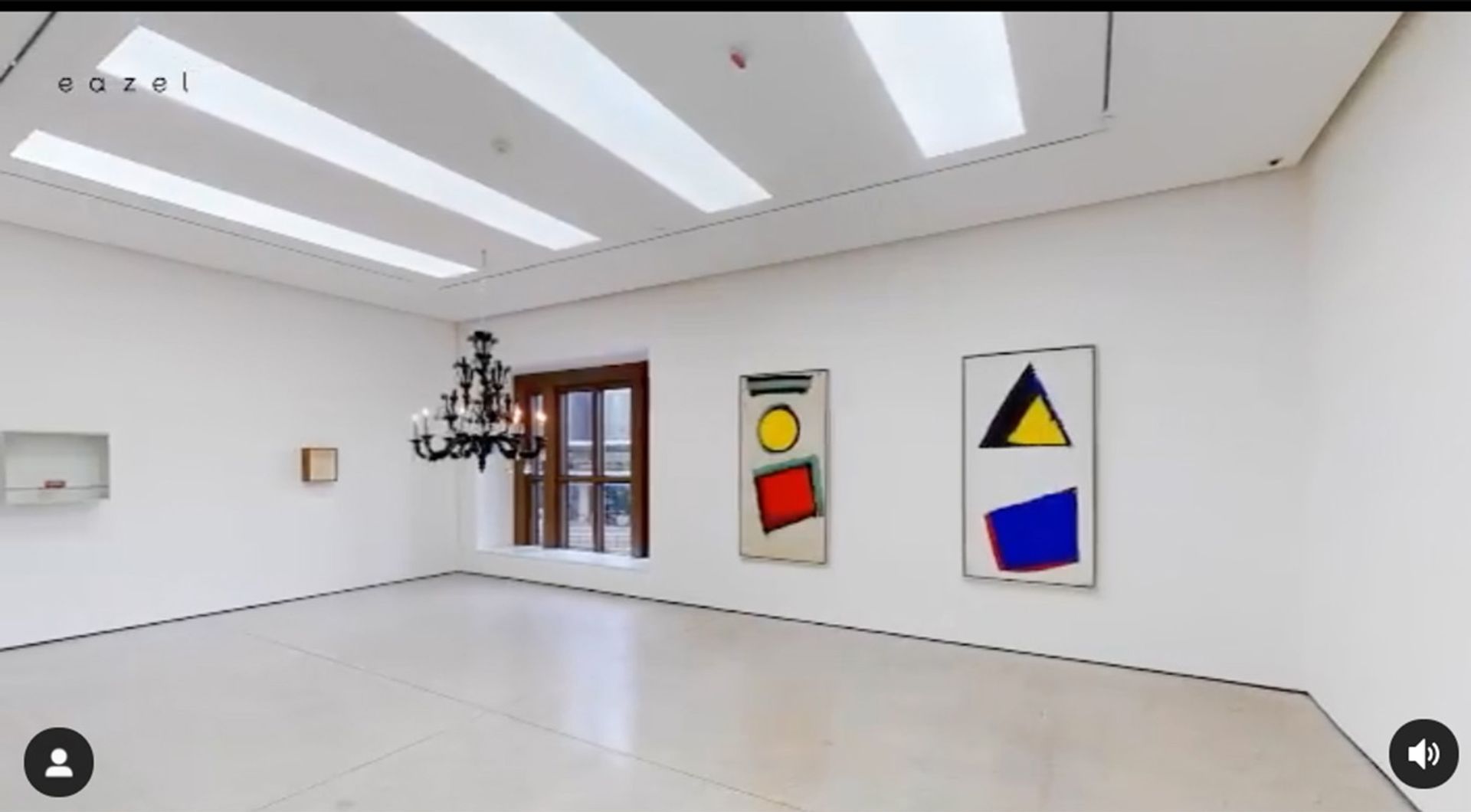
Users can navigate from one hotspot to another using their mouse, with an additional zoom ability to get closer to the artworks
Carole Chainon: Eazel uses the Matterport camera to create virtual tours using hotspots. Users can navigate from one hotspot to another using their mouse, with an additional zoom ability to get closer to the artworks.
Dhiren Dasu: The standard rules apply on pan, tilt, zoom, click on viewpoint, and click on object.
Seol Park: Like many other virtual exhibitions incorporating spatial scanning, rendering, and hotspot-based navigation of this nature, this show presents artworks in an environment in which time stands still. For the viewer, navigating Matterport virtual spaces often feels like walking around alone in a world where everyone and everything—including Cerith Wyn Evans' otherwise-flickering chandelier—has suddenly come to a pause.
Does it break new ground technically?
Barring the actual viewing of a physical work, this inclusive and informative XR approach bests the real world in most of the ways that matterDhiren Dasu
Carole Chainon: The app doesn’t break new grounds technically but it is wonderful to see more and more galleries use immersive technologies.
Dhiren Dasu: There were no novel technical leaps. However I do feel that this was one of the best renditions of what XR technology can do. In one user experience I was able to see the exhibition, look at works in detail, find out about the artist's raison d'être and history, as well as have a potential conversation with a gallerist on how to purchase the work. In my experience, in the gallery and crowded art fair scene, neither artists nor collectors/ patrons/ casual viewers get this level of attention or information. Barring the actual viewing of a physical work, this inclusive and informative XR approach bests the real world in most of the ways that matter.
Seol Park: Though this project does not introduce any novel invention per se, the technological leap here lies in its solid execution of the virtual gallery navigation technology as it stands. The platform's seamless interaction design suggests the producers' intimate understanding of the technology, the stakeholders in the art ecosystem, and their user behaviours.
The Art Newspaper’s XR Panel
Gretchen Andrew is a Search Engine Artist and Internet Imperialist who has manipulated the US presidential election with art and desire. Her next exhibition is with Annka Kultys in February 2021.
Carole Chainon is the co-founder of JYC, an XR development and production studio based in Los Angeles with a presence in Europe, creating XR experiences for the entertainment and enterprise sector. She is also a Spark AR Creator.
Dhiren Dasu is a digital media creator and consultant. His areas of speciality include photography, film, virtual space, graphic design, visual effects, animation, and audio production. Dasu, in his fine art persona as Shapeshifter7, makes artworks that echo and recompose the architectural spaces he photographs, turning them into immersive spaces while exploring the nexus of photography, collage, symbols, and perception.
Seol Park bridges technology, art, and branding. After working with Microsoft and INTEL, she now guides global branding at LG with emphasis on digital and cultural engagement. Her past work in XR has appeared in Media-N, ABC TV (Australia), The Southern Star (Ireland), and more. She was named in Sotheby's Institute's "4 Under 40" in 2019, and serves on the Board of Trustees for The American Folk Art Museum.
Eron Rauch is an artist, writer, and curator whose projects explore the infrastructure of imagination, with a focus on subcultures, video games, and photography history.


